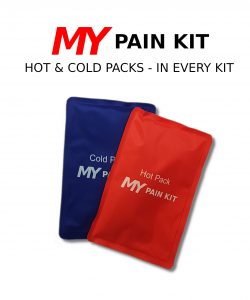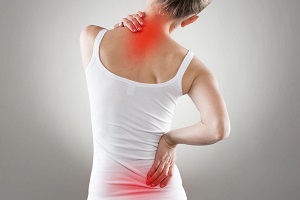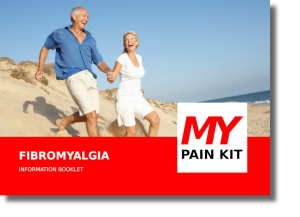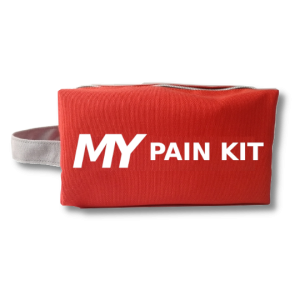After two decades in clinical practice across three clinics, we still find fibromyalgia a difficult condition to treat and get real long term relief for our patients. Consistency is key, and we believe My Pain Kit can help with Fibromyalgia…
What Is Fibromyalgia?
Fibromyalgia is a term that relates to a set of symptoms which typically includes widespread body pain (usually neck, shoulders, back and pelvis but can also involve the limbs as well as headaches). It is also usually associated with a feeling of muscle tension, touch tenderness of the muscles, and feelings of fatigue and sleep pattern disturbance.
This may also be associated with symptoms such as dizziness, brain fog, headaches, stomach pain, period pain and depressed mood. We need to at least try and solve Fibromyaigla with a drug-free pain-relief approach!
Fibromyalgia Symptoms
The symptoms of fibromyalgia can be very distressing and debilitating with huge feelings of hopelessness about what to do. Researchers still haven’t discovered what causes this ailment. Some believe it could be an abnormality in how your brain processes the pain messages from your nerves.
Fibromyalgia means the structures of the body are sensitive but usually not damaged, so X-rays and MRI scans are rarely helpful in treatment. The painful structures associated with Fibromyalgia such as joints or muscles are related to widespread changes within the nervous system. So treating specific structures most likely won’t provide any long-term benefits.
Fibromyalgia means you might experience pain more so than the average person. An over-sensitive nervous system may be the cause of your increased experience of pain which can lead to a cascade of debilitating factors including pain, poorer sleep patterns, depression etc.
Why is Fibromyalgia So Difficult To Treat?
One of the main reasons I have found is that every patient is different. Some patients really benefit from massage, stretching and strengthening exercises. Others don’t. They feel it aggravates their symptoms!
- There are Patients who swear by Chiropractic and Osteopathy Treatments
- Then, there are other people for whom Heat Treatments and Hot Baths help
- Others prefer Cold and Ice Treatment
And here lies the challenge: When it comes to Fibromyalgia, we must listen to our patients and find what works for them! We let them tell us what works and only then can we devise a plan that they can work with. I have found most people benefit from exercise programs and walking. I feel it’s about creating a tailored routine for each patient and allowing them to take control of their pain. Ultimately patients need to move towards self-managing their fibromyalgia, alongside the treatment and advice from their Therapist.
What Treatments Work For Fibromyalgia most of the time?
A wide-symptom ailment requires a wide-treatment solution!

Heat
A lot of our patients have experienced that when they apply heat to a particularly painful area, this can greatly help. Most of what we do involves applying heat to an affected area, because this can increase blood-flow, and prepares the body to heal – it also feels amazing!

Massage, Move, Stretch, Strengthen
The methodology contained within our Pain Kit we believe is particularly applicable to Fibromyalgia. It’s not like you’re treating a specific injury in one body location – but a routine incorporating the key elements, in a light manner can be very effective in slowly alleviating the painful
We have to stress the “Move” component! Even though exercise and movement can often be painful, engaging with exercise gradually and frequently can reduce the symptoms over time. Low impact aerobic exercise such as walking or biking increases the endorphins (natural pain-killers) in your body helping you to feel better and take the focus of your pain.
Gentle yoga, tai-chi, pilates, mobility, stretching and strengthening exercises will help strengthen your body, decrease stiffness and increase range of motion of your joints. This CAN help keep your pain levels lower.
Stress Relief
Exercise is also a great mechanism for stress relief, an important tool in the treatment for fibromyalgia! Learning to manage stress and practicing relaxation techniques / meditating can help calm the nervous system. Learning cognitive techniques (positive ways of thinking) can reduce the body’s response to stress.
Improving Sleep Patterns
Again, exercise can be just as effective in helping you get better sleep than sleep medication. Developing consistent and healthy sleep habits is a key aspect of treatment.
Improve Your Diet
There are many advocates in the medical and dietary communities for an anti-inflammatory diet which they believe can help greatly with Fibromyalgia. If you aren’t eating healthily now, you should do so – to lose weight and improve energy.
Plant-based and even Mediterranean diets score highly on anti-inflammatory scores!
Frequently Asked Questions:
Not exactly, because Fibromyalgia is often a lifelong illness, but you can learn to live with it, and minimise the symptoms and pain associated with it. Expensive massage and treatments can add up, so you can always try combining useful activities into your daily routine. Consider:
- Bracing / Support
- Heat Therapy
- Massage
- Movement
- Stretch Exercises
- Strength Exercises
- Cold Therapy
For Back Pain you need a diagnosis from a trained medical professional, and they will discover what is the cause. Very commonly people are injured, or have developed Osteoarthritis which is giving them Back Pain.
Fibromyalgia may be diagnosed after you have exhausted all the other possibilities. If you don’t have an underlying back pain issue, this could point towards the more generalised pain symptoms indicating Fibromyalgia.
In a lot of cases, getting exercise does help Fibromyalgia symptoms, along with living a more healthy lifestyle. If you need to lose weight, or manage your stress, these can also be lifestyle changes that give a beneficial effect. A Chiropractor can treat many of the symptoms of Fibromyalgia too, and if this becomes expensive, you could consider a self-management approach by doing your own exercises and stretches.








